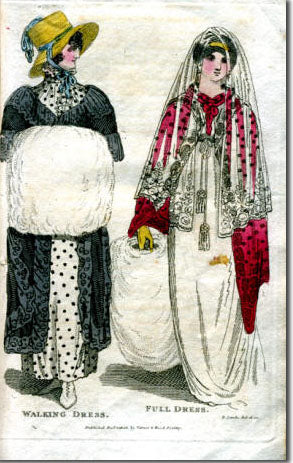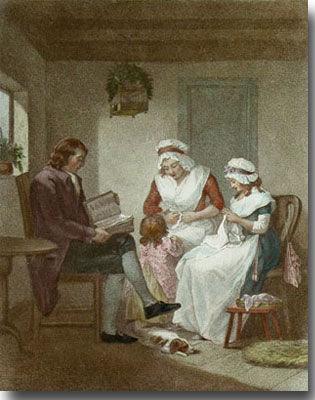Fashions for October 1807 from La Belle Assemblee

English Costume No. 1 A Lady and her Child Attired in the Most Elegant Fashions of the Season
Explanation of the Prints of Fashion
Lady's Dress.—A round gown with short train, ornamented at the feet in flutings of muslin or needlework; a long sleeve rucked, with full top; frock back, and lappelled bosom cut low, and trimmed with scolloped lace. A Chapeau A la bocage, of imperial chip or sarsnet, ornamented with a wreath of ivy or jonquille; a single sprig of the same in front of the bosom in lieu of a brooch. A shawl of Chinese silk, thrown negligently over the shoulders. Hair in a single band across the forehead, relieved by loose curls in front and at the sides. Hoop earrings of amber or cornelian. Straw-coloured kid gloves and shoes.
Child's Dress.—A frock and trowsers of fine cambric, bordered at the bottom in rich fancy Vandyke; French back, and bosom cut very low, and ornamented with the same ; Circassian sleeve very short. The Moorish boot, or high pomposa; of bright yellow kid, laced with purple. Sash to correspond, tied in shorthows and ends behind. 
Parisian Costume. No. 2. A Parisian Dancing Figure.
A round frock of Italian crape, over a white satin slip, ornamented at the bottom with a pink and silver ribband. Long waist, laced up the back with pink or silver chord; a plain bosom cut very low, trimmed tel que la robe. The melon sleeve, formed of alternate stripes of pink satin and white crape; a narrow sash of pink ribband, tied loosely behind. Hair combed straight from the temples, and leaving a few simple curls on the forehead, is formed in full braids at the back of the head, confined with a coronet comb of pearl, and ornamented with a bunch of auricula or clove-carnation. A bouquet composed of the rose and myrtle. Necklace, earrings, and bracelets of fine Chinese pearl. Gloves of French kid, and slippers of pink satin, tied round the ankles with silver ribband. Plain silk stockings, a French white.
General Observations on the Most Prevailing Fashions for the Season
As our metropolis cannot at this period be properly termed the theatre of fashion, we of course direct our attention to those places of public and private resort, where she still reigns triumphant. Genius and talent are confined to no period or clime,—taste and fancy are their offspring, and fashion their conductor and Chaperon. The celebrated watering place exhibit at the moment an assemblage of beauty and elegance; the balls and theatres, public walks and libraries, were never more crowded; and the splendour, luxury, gaiety, and hospitality displayed at the seats of our nobles, and the villas of our females of fashionable eclat, are emblematic of that national prosperity which, spite of our Continental foe, is still the pride and boast of Albion. It is to the opportunity of observation afforded us from the above-mentioned sources, that we are enabled to give a delineation more copious and select than at this season of the year it might otherwise be in our power to procure, and which, we are proud to say, will he sought for in vain amidst the pages of any cotemporary work.
Our fair readers will be sensible that at this intermediate season no great degree of novelty presents itself; but still amidst our general information, we shall hope to pourtray some variety in individual articles; while we at the same time endeavour to direct the taste in its selection and combination of that attire which produces an attractive and elegant tout ensemble. Attention to the morning and intermediate costume, we strongly enforced in our last; it will therefore only be necessary here to specify such articles as are most worthy of distinction in this and every other style of fashionable decoration.
The Carmelite, or Convent cloak, of coloured sarsnet; the Pedlar's cloak, and Rugen mantle, of Chinese silk, trimmed with Vandyke brocade ribband; the large Angola, or silk shawl, near two yards square, gathered full around the throat, and tied in a full bow on the shoulder, the ends falling irregularly down the left side, and finished with tassel, are considered the most distinguishing in this style of ornament. The hat a la Diana- of black chip, with coloured net embroidered handkerchiefs; the Spanish hat, of black satin-straw, ornamented in front with autumnal flowers; straw, or white chip hats, with Vandyke and scolloped edges', and small Scotch bonnets, of fancy sarsnets, edged with French binding, and trimmed with a full Angola fringe, are selected by females of the first rank and fashion. The curled ostrich feather placed across the crown of the head is much introduced in full dress, and has a most novel and appropriate effect. Flowers are much worn, and variously disposed; the barberry, the ranunculus, the clove- carnation, and Labrador rose, we observe to rank highest on the list of fashion. Habit shirts of lace or embroidery, with a deep Vandyke falling frill, and the shirt with lace introduced in the melon form, gathered round the throat with a border of the same, are articles perfectly new and attractive.
The style of gowns vary little since our last communication. The morning dress is made high in the neck as usual, and formed in a plain cambric robe, a walking length ; with belts a la Diana, and deep Vandyke ruff, or in jackets and petticoats ornamented with work, lace, or muslin. French coats, or breakfast wraps, continue their station in the morning wardrobe, and this style of costume is considered incomplete and inelegant without a cap; this latter ornament usually consists of the Brunswick mob, French quartered cap, or nun's hood of lace, lined with coloured sarsnet, and edged with a narrow rich Vandyke, the latter is an article comprising much novelty and elegance. Round gowns of muslin, either short or with trains, edged at the feet with narrow Vandyke, or cut in large crescent scallops, and edged with a fine pearl net, worn with a military sash of white sarsnet, must ever be ranked amidst a chaste and fashionable attire. Robes of coloured muslin or crape, worn over white satin, trimmed with fancy trimming of chenille, beads, or silver, and a cestus to correspond, are considered uncommonly elegant and attractive, painted, or embroidered borders representing natural flowers, on muslin or tiffany robes, it is thought will be much introduced in full dress during the winter, at present we only notice a few in the very first circles of rank and fashion. Grecian drapery, folded in a picturesque style round the figure, is also observable in the ballroom; but at this season of the year to he considered of fashionable distinction, public decoration should be chaste and elegant, rather than showy and splendid. In the- evening parade, the hat may be ornamented with a flower; but we wish that many of our females would distinguish and regulate with greater nicety, and not allow those ornaments to form any part in the morning decoration.
The Provence hat, Cottage bonnet, or small straw hat and veil, are appropriate to the morning walk, and flowers (that animating and consistent decoration of the evening dress)-must ever be considered in the above-mentioned costume a vulgar supernumerary. We have lately seen a dress which, from its simplicity and elegance, attracted universal attention; it consisted of a plain short gown of leno or crape, worn over a white satin slip; at the bottom was laid a broad satin ribband, finished at the extreme edge with a narrow Vandyke lace; a Spenser waist with short sleeve, composed entirely of crape and satin ribband formed in plaits; a winged ruff of scolloped lace ornamented the back and shoulders ; and a small hat of the Spanish form, with a willow feather, frosted with silver, waving over the crown towards the left side where the hat inclined, composed the head-dress. The trinkets were entirely of brilliants set in the most fashionable form; the shoes were white satin, with silver rosets; the fan of white tiffany, with lilies of the valley in silver; and a bouquet consisting of the myrtle, mignionette, and Provence rose, completed this almost celestial attire. Dresses of black, or coloured net, over white satin slips, with rich appliqued borders in coloured chenille or white beads are the distinguishing decoration of many females of rank on public occasions. White and coloured embroidered net handkerchiefs, are still considered extremely fashionable, both as ornaments for the hair and to tie down the gipsy hat.
Tuckers of net, formed in the honey-comb edge, or trimmed with Vandyke or scolloped lace, are introduced with those dresses which are cut low in the bosom. Bindings of embroidery continue a favourite ornament for muslin and cambric dresses, and it is now not only introduced round the bottom and bosom but up the seams of dresses, and we have not witnessed an embellishment more neat and appropriate. The short sleeve, if formed of lace or with a Vandyke cuff, must only be of an easy fullness; if of the same material as the dress, they are disposed in the melon or bishop form, but each very short, finished with hair or pearl armlets. We have seen nothing in the long sleeve more elegant than those described in our last; nor can there be any covering for the arm more becoming and attractive than the Catalani and surplice twisted sleeve, confined at the wrist with elastic bracelets of gold or hair.
Some dashing elegantes have lately sported stockings of brown and purple silk, with coloured clocks and open-wove anklet. But we cannot help remarking that this feature of the human form, when rendered conspicuous by the singularity of its decoration, will attract without pleasing; we naturally turn with disgust from that species of art which obscures and disguises the symmetry of nature; we confess ourselves a votary to neatness and elegance combined; and therefore wish not to see the above mentioned fashion become general amongst females who have been celebrated for unobtrusive loveliness, simplicity, and virtue. We have little to remark on the articles of trinkets, they have undergone little alteration since our last Number; the wedding hoop-ring, with a single brilliant, ruby, emerald, or amethyst in the centre ; the Carmelite cross, the jessamine brooch, with bottles formed of Egyptian amulet wood embellished with correspondent characters, are the only ornaments in this line which strike us as worthy of observation. Gloves and shoes are governed by no particular Standard, but left to the choice of the wearer; the prevailing colours for the season are, rose, green, purple, salmon, and melbourn brown.
Enjoyed this article? Visit our giftshop and escape to the world of Jane Austen for costume, patterns and more.



Leave a comment
This site is protected by hCaptcha and the hCaptcha Privacy Policy and Terms of Service apply.